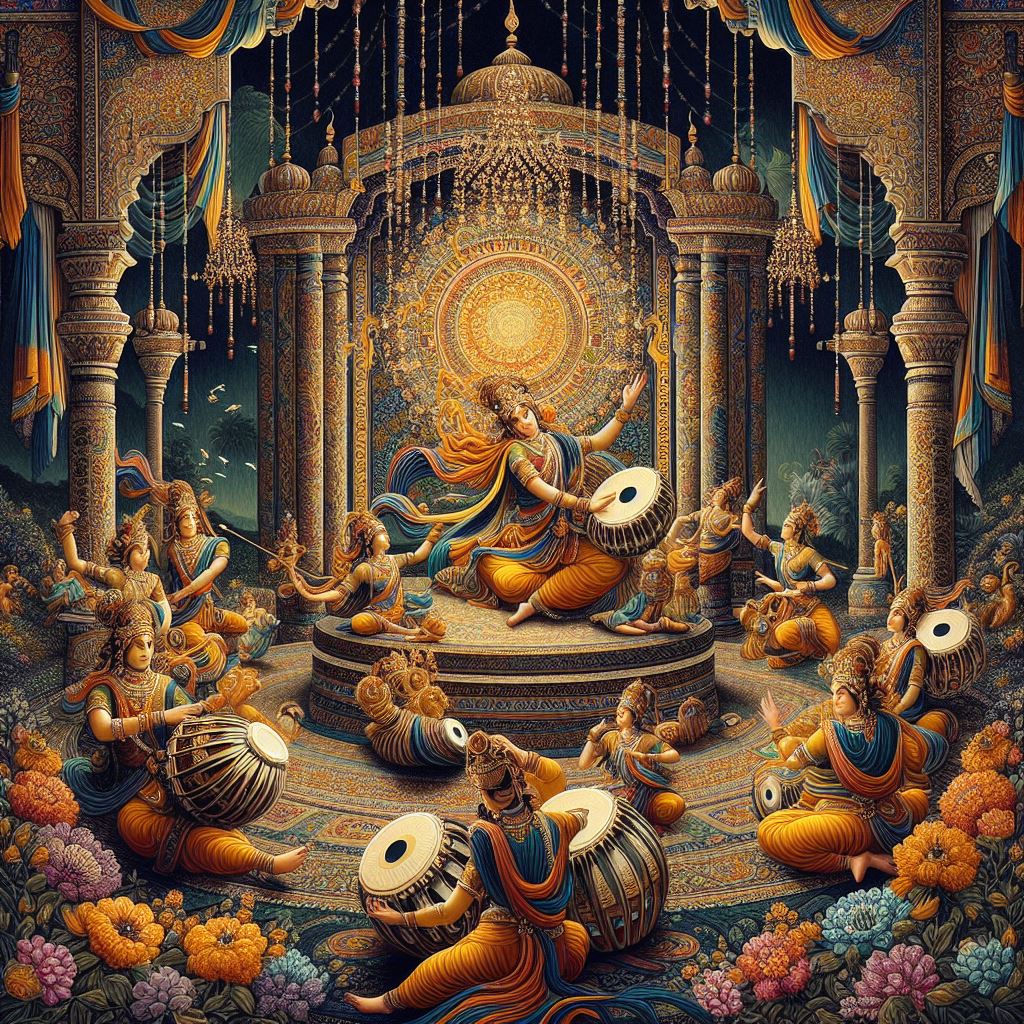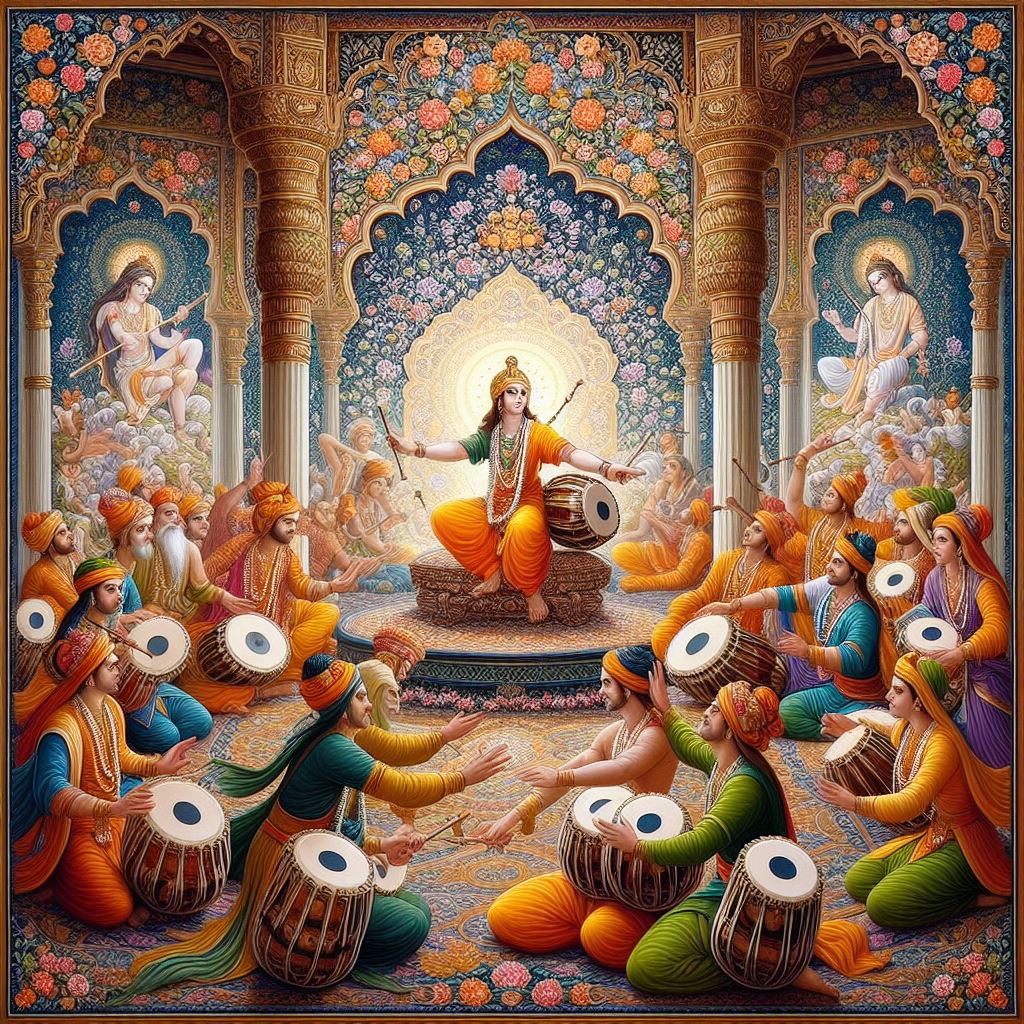Introduction
In the rich Tapestry of devotional tracks, the tabla emerges as a rhythmic maestro, guiding the non-secular journey with its percussive beats. Shri Ram Dhun, a sacred chant committed to Lord Rama, unearths a fascinating dance associated with the tabla. This exploration delves into the intricate rhythms and pulsating beats of the tabla, unravelling the Tapestry of Shri Ram Dhun as it weaves together the divine melody and the rhythmic dance of devotion.
The Tabla: A Percussive Poetry
- Origins and Evolution:
The tabla, a conventional Indian percussion device, has historical roots that trace lower back to the Indian subcontinent. Its evolution from ancient drums and the amalgamation of numerous influences formed it into the versatile and expressive device recognized today. Consisting of hand-performed drums – the smaller, better-pitched Dayan and the larger, lower-pitched bayan – the tabla is characterized with the aid of its intricate production and capacity to produce a wide range of tones.
- Symbolism in Tabla Playing:
In the context of a devotional song, the tabla takes on symbolic significance. The rhythmic styles produced via the tabla are often seen as symbolic of the cosmic dance of the divine. With each stroke, every beat becomes a step inside the rhythmic journey, guiding the listener and the performer in the direction of religious elevation. In the palms of a skilled tabla participant, the device turns into a conduit for expressing the complex rhythms of devotion.
Shri Ram Dhun: A Melodic Odyssey
- Overview of Shri Ram Dhun:
Shri Ram Dhun is a devotional chant that revolves around the repetition of the sacred name “Ram.” Rooted inside the non-secular traditions of Hinduism, this melodic composition celebrates the virtues and divine attributes of Lord Rama. The repetitive chanting becomes a meditative practice, inviting devotees right into a sacred area where the mundane fades away and the divine takes the middle stage.
- Role of Melody and Rhythm:
Shri Ram Dhun, as basically an m, episodic composition, achieves its full expression via a sensitive interaction of melody and rhythm. The rhythmic factors, frequently provided by units like the tabla, infuse dynamism into the chant, raising it from a simple melodic repetition to a colourful and attractive spiritual journey.
The Tabla’s Dance in Shri Ram Dhun
- Foundations of Tabla Playing:
To understand the tabla’s dance in Shri Ram Dhun, it’s essential to delve into the foundational aspects of tabla gambling. The player’s fingers strike the drumheads with specific and calculated movements, generating a number of sounds and tones. The tabla’s unique construction allows for the modulation of pitch and timbre, presenting a wealthy palette for rhythmic expression.
- Bols and Thekas:
The language of the tabla is conveyed through bols, mnemonic syllables representing specific strokes or combos. Thekas, rhythmic cycles, form the backbone of tabla compositions. The interplay of bols within those cycles creates complex rhythms, including layers of complexity in the percussive panorama. In the context of Shri Ram Dhun, the tabla participant weaves bols and thekas into the melodic Tapestry, improving the rhythmic dynamics of the chant.
- Tala System:
Central to tabla gambling is the tala system, an advanced framework of rhythmic cycles. Common talas like Teental and Dadra offer the structure for the tabla participant to build intricate rhythmic patterns. In the rendition of Shri Ram Dhun, the choice of tala impacts the pacing and character of the rhythmic dance, permitting the tabla to resonate harmoniously with the melodic elements.
- The Art of Improvisation:
A hallmark of professional tabla gambling is the artwork of improvisation. A seasoned tabla participant in the context of Shri Ram Dhun introduces variations, gildings, and improvisational terms in the rhythmic framework. This spontaneous creativity enhances the emotional depth of the mantra, creating a dynamic speech between melody and rhythm.
Harmonious Collaboration: Harmonium and Tabla in Shri Ram Dhun

- Synchronization of Melody and Rhythm:
In the rendition of Shri Ram Dhun, the harmonium and tabla interact in a symbiotic dance. The harmonium presents the melodic basis, sustaining the divine cadence with its continuous flow of sound. Simultaneously, the tabla punctuates the melodic adventure with rhythmic accents, growing a dynamic partnership. The synchronization of melody and rhythm becomes a key detail in elevating the holy experience.
- Call-and-Response Dynamics:
The interaction between the harmonium and tabla frequently takes on name-and-response dynamics. The harmonium initiates a melodic phrase, and the tabla responds with rhythmic styles, growing a musical talk. This interplay provides a conversational excellent to the rendition, enhancing the emotional and non-secular resonance of Shri Ram Dhun.
- Dynamic Contrast:
The tabla’s ability to supply a wide variety of dynamic contrasts becomes mainly mentioned in collaboration with the harmonium. The juxtaposition of soft and thunderous strokes and rapid and languid rhythms provides a layer of texture to the devotional composition. This dynamic contrast heightens the general impact, retaining the listener engaged and immersed in the rhythmic journey.
Tabla Maestros and Their Artistry in Shri Ram Dhun
- Ustad Zakir Hussain:
A dwelling legend in the international of tabla playing, Ustad Zakir Hussain has validated unheard-of artistry in diverse musical genres, such as devotional tracks. His mastery of rhythm and elaborate tabla compositions is evident in his collaborations with vocalists in the rendition of Shri Ram Dhun. The fluidity and precision of his tabla gambling beautify the religious depth of the mantra.
- Pandit Anindo Chatterjee:
Renowned tabla maestro Pandit Anindo Chatterjee has made massive contributions to the world of classical and devotional music. His nuanced method of tabla playing, characterized by complex bols and rhythmic finesse, provides a layer of sophistication to the rendition of Shri Ram Dhun. His collaborations with vocalists show off the tabla’s potential to explicit the intricacies of devotion through rhythm.
- Ustad Alla Rakha:
Often called the “Einstein of Percussion,” Ustad Alla Rakha became a trailblazer in the world of tabla gambling. His collaborations with sitar maestro Pandit Ravi Shankar and other renowned musicians encompass soul-stirring renditions of devotional compositions. His command over the tabla’s rhythmic nuances added an undying nice to Shri Ram Dhun.
Devotional Impact: Beyond Sound and Rhythm
- Meditative Experience:
The tabla’s dance in Shri Ram Dhun extends beyond a trifling auditory enjoyment; it will become a meditative journey. The rhythmic pulsations, guided by using the tabla player’s professional fingers, induce a trance-like nation. Devotees discover themselves immersed in the meditative cadence, transcending the boundaries of the international fabric and connecting with the divine.
- Expressive Emotions:
The tabla’s rhythmic dance has the strength to awaken a spectrum of emotions. From joyous celebrations to introspective contemplation, the tabla enhances the expressiveness of Shri Ram Dhun. The percussive beats turn out to be a car for the conveyance of devotion, permitting worshippers to articulate their emotions via the language of rhythm.
- Community Participation:
In communal worship settings, the tabla’s presence adds a communal size to the devotional enjoyment. As the tabla player weaves rhythmic styles, the congregation turns into an integral part of the religious dance. The collective participation complements the feel of harmony and shared devotion, creating a harmonious ecosystem in which personal rhythms merge right into a collective heartbeat.
Learning the Tabla for Shri Ram Dhun
- Guidance from a Guru:
Learning the tabla is a conventional and guru-centric method. Aspiring tabla players frequently search for steerage from a guru who imparts now not only the simplest technical skills but also the non-secular and cultural nuances embedded in tabla playing. The guru-disciple relationship fosters a deep reference to the tool and its devotional expressions.
- Technical Foundations:
Mastering the tabla requires a solid foundation in fundamental techniques. This consists of mastering the perfect hand positions, finger strokes (called “taals”), and rhythmic compositions. The technical skillability lays the basis for expressive playing and improvisation within the context of Shri Ram Dhun.
3. Rhythmic Cycles and Patterns:
Understanding rhythmic cycles (tala) and patterns is crucial for gambling Shri Ram Dhun at the tabla. Aspiring tabla players must familiarize themselves with not unusual talas and increase their ability to create intricate rhythmic styles inside these cycles. This talent forms the basis for dynamic and expressive tabla gambling.
Four. Listening and Observation:
Active paying attention to diverse renditions of Shri Ram Dhun, providing tabla gamers, is a treasured gaining knowledge of the tool. Observing the techniques employed with the aid of master tabla gamers gives insights into the nuances of devotional expression. Immersing oneself in the rich tradition of tabla gambling is crucial to growing profound expertise of its function in devotional tune.
Contemporary Expressions and Collaborations
- Fusion with Global Genres:
In present-day musical landscapes, tabla gamers are increasingly exploring collaborations with artists from diverse genres. Fusion initiatives deliver the tabla’s rhythmic dance into dialogue with Western, jazz, and global tune influences. Such collaborations no longer only show off the versatility of the tabla but also bridge cultural divides, increasing the horizons of devotional expression.
- Digital Platforms and Global Audiences:
The creation of virtual platforms has facilitated the worldwide dissemination of devotional tracks offering the tabla. Performances of Shri Ram Dhun, with the aid of tabla virtuosos, can now attain audiences around the arena, fostering a regularly occurring appreciation for the rhythmic dance of devotion. Virtual collaborations and online platforms offer opportunities for tabla players to interact with diverse audiences and contribute to the global talk of spiritual expression.
Conclusion:
In the rhythmic dance of the tabla inside Shri Ram Dhun’s Tapestry, we discover an eternal cadence that echoes via the corridors of devotion. The tabla, with its tricky patterns and percussive brilliance, will become more than an instrument; it transforms right into a spiritual manual, main worshippers on a rhythmic journey in the direction of the divine. The tabla participant becomes a storyteller, weaving narratives of devotion through strokes and rhythms.
The dance of hands at the tabla’s surface mirrors the dance of the soul, seeking union with the divine. From the foundational strategies to the suave improvisations, the tabla’s position in Shri Ram Dhun is a testament to the profound connection between rhythm and devotion. The tabla reverberates with the timeless echoes of devotion. It transcends cultural boundaries, inviting human beings of various backgrounds to enrol in the rhythmic celebration of the divine. The tabla’s dance in Shri Ram Dhun is an affidavit to the iconic energy of tune to elevate the spirit, speak the ineffable, and create a sacred area in which the rhythm of devotion will become an everlasting symphony.
About Us and Feedback
Wе hopе that you will find this information usеful, and if you arе satisfiеd with thе information you havе rеcеivеd from us, plеasе providе us with your fееdback and lеt us know what kind of information about Indian musical instrumеnts wе can providе to you in thе futurе for thе еntirе globе.
